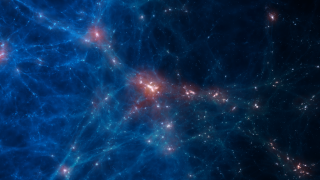Bibcode
Santos-Santos, Isabel M.; Di Cintio, Arianna; Brook, C. B.; Macciò, Andrea; Dutton, Aaron; Domínguez-Tenreiro, Rosa
Referencia bibliográfica
Monthly Notices of the Royal Astronomical Society, Volume 473, Issue 4, p.4392-4403
Fecha de publicación:
2
2018
Número de citas
80
Número de citas referidas
72
Descripción
The significant diversity of rotation curve (RC) shapes in dwarf
galaxies has recently emerged as a challenge to Λ cold dark
matter (ΛCDM): in dark matter (DM) only simulations, DM haloes
have a universal cuspy density profile that results in self-similar RC
shapes. We compare RC shapes of simulated galaxies from the NIHAO
(Numerical Investigation of a Hundred Astrophysical Objects) project
with observed galaxies from the homogeneous SPARC data set. The DM
haloes of the NIHAO galaxies can expand to form cores, with the degree
of expansion depending on their stellar-to-halo mass ratio. By means of
the V2kpc-VRlast relation (where VRlast
is the outermost measured rotation velocity), we show that both the
average trend and the scatter in RC shapes of NIHAO galaxies are in
reasonable agreement with SPARC: this represents a significant
improvement compared to simulations that do not result in DM core
formation, suggesting that halo expansion is a key process in matching
the diversity of dwarf galaxy RCs. Note that NIHAO galaxies can
reproduce even the extremely slowly rising RCs of IC 2574 and UGC 5750.
Revealingly, the range where observed galaxies show the highest
diversity corresponds to the range where core formation is most
efficient in NIHAO simulations, 50 < VRlast/km
s-1 < 100. A few observed galaxies in this range cannot be
matched by any NIHAO RC nor by simulations that predict a universal halo
profile. Interestingly, the majority of these are starbursts or
emission-line galaxies, with steep RCs and small effective radii. Such
galaxies represent an interesting observational target providing new
clues to the process/viability of cusp-core transformation, the
relationship between starburst and inner potential well, and the nature
of DM.
Proyectos relacionados

Astrofísica Numérica: Formación y Evolución de Galaxias
Entre las cuestiones fundamentales en Astronomía y Astrofísica están la formación y evolución de galaxias. Las escalas de tiempo y tamaño son tan astronómicas que su observación en galaxias individuales es imposible. Solo con el uso de simulaciones numéricas es posible entender la formación de estructuras cósmicas dentro del actual marco
Claudio
Dalla Vecchia

Huellas de la Formación de las Galaxias: Poblaciones estelares, Dinámica y Morfología
Bienvenida a la página web del g rupo de investigación Traces of Galaxy Formation. Somos un grupo de investigación amplio, diverso y muy activo cuyo objetivo principal es entender la formación de galaxias en el Universo de una manera lo más completa posible. Con el estudio detellado de las poblaciones estelares como bandera, estamos constantemente
Anna
Ferré Mateu